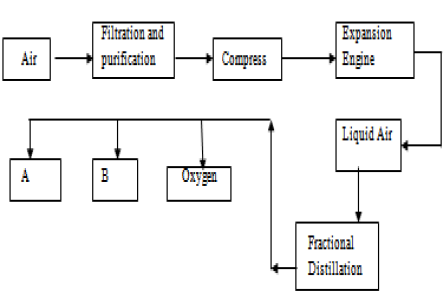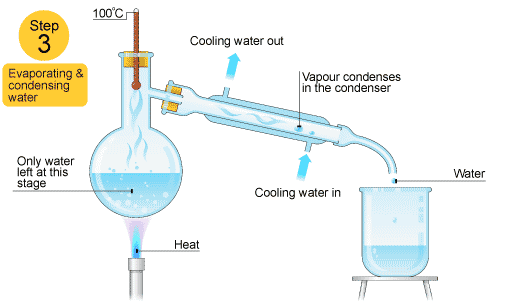

That vapor will pass up the column until the temperature falls enough for it to condense to give a liquid richer in B than the one in the flask (equivalent to M1 in the diagram). The vapor over the boiling liquid in the flask will be richer in B than the original liquid is.
B is the more volatile liquid A is the less volatile one. If it is above that, then your distillate will still contain some of the less volatile component. If it is below that, then nothing is going to pass out into the condenser. That means that the thermometer has to read exactly the boiling point of the more volatile liquid. You have to be sure that only the vapor of the more volatile of the two liquids passes into the condenser. When you finally get to that point and condense the vapor, then you will have pure B liquid. If you go on doing that, reboiling and recondensing, then the vapor becomes richer and richer in B until it eventually becomes pure B. 
The vapor over that liquid will have a composition M2, still richer in B. If you reboil that, it will boil at a temperature T2. If you condense that vapor, it will give a liquid of the composition M1. The vapor above the liquid at this temperature will be richer in the more volatile substance B.
If you boil the mixture M, it will boil at a temperature T1. If you didn't have the packing, the liquid would all be on the sides of the condenser, while most of the vapor would be going up the middle and never come into contact with it. By having a lot of surface area inside the column, you aim to have the maximum possible contact between the liquid trickling down and the hot vapor rising. To make the boiling-condensing-reboiling process as effective as possible, it has to happen over and over again. Finally, what is the point of the packing in the column? If you are very, very careful over temperature control, eventually you will have separated the mixture into B in the collecting flask and A in the original flask. So, over time, as B passes out of the top of the column into the condenser, the liquid in the flask will become richer in A. By the time the liquid drips back into the flask, it will be very rich in A indeed. As the condensed liquid trickles down the column constantly being reboiled by up-coming vapor, each reboiling makes it richer and richer in the less volatile component - in this case, A. So what about the liquid left behind at each reboiling? Obviously, if the vapor is richer in the more volatile component, the liquid left behind must be getting richer in the other one. Notice that the thermometer bulb is placed exactly at the outlet from the fractionating column. The mixture is heated at such a rate that the thermometer is at the temperature of the boiling point of the more volatile component. 
In some cases, where you are collecting a liquid with a very low boiling point, you may need to surround the collecting flask with a beaker of cold water or ice. There has to be a vent in the system otherwise the pressure build-up when you heat it will blow the apparatus apart. If you sketch this, make sure that you do not completely seal the apparatus. Some fractionating columns have spikes of glass sticking out from the sides which serve the same purpose. The fractionating column is packed with glass beads (or something similar) to give the maximum possible surface area for vapor to condense on. (CC BY-SA 3.0 Theresa knott via Wikipedia) Here the distillation head and fractionating column are combined in one piece. An Erlenmeyer flask is used as a receiving flask. It is not quite so obvious how you get a sample of pure A out of this.Ī typical lab fractional distillation would look like this: Fractional distillation setup. The secret of getting the more volatile component from a mixture of liquids is obviously to do a succession of boiling-condensing-reboiling operations. You can see that if you were to do this once or twice more, you would be able to collect a liquid which was virtually pure B.
Reboiling the liquid C 3 will give a vapor still richer in the more volatile component B (the green lines). Again you can condense that to give a liquid of the same new composition (the red lines). If you reboil that liquid C 2, it will give a vapor with composition C 3. If you boil a liquid mixture C 1, you will get a vapor with composition C 2, which you can condense to give a liquid of that same composition (the pale blue lines). The next diagram is new - a modified version of diagrams from the previous page. I want to start by looking again at material from the last part of that page. On the last page, we looked at how the phase diagram for an ideal mixture of two liquids was built up.







 0 kommentar(er)
0 kommentar(er)
